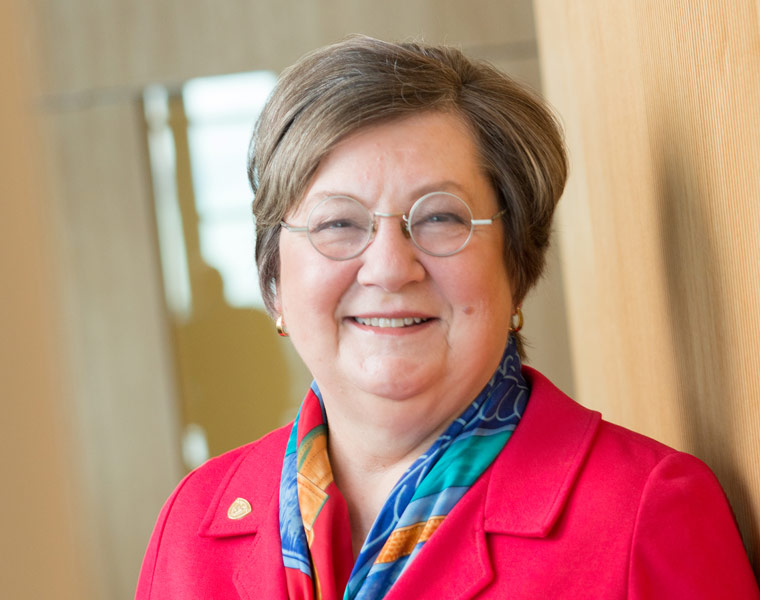Tenure included Northeast Ohio’s two largest federal research grants, gains for Case Comprehensive Cancer Center and Cleveland Clinic collaboration to create Health Education Campus
After a 13-year tenure that saw the School of Medicine swing from multi-million-dollar deficits to record-breaking fundraising and research awards, Pamela B. Davis will return to the faculty full-time as of July 1.
“We have achieved so much thanks to remarkable faculty and dedicated staff members who advance our mission every day,” Davis wrote Monday in a farewell email to the school community. “I am also deeply thankful for the outstanding students who will carry on our legacy, the alumni who have helped to make us who we are, and the friends and supporters who make our progress possible. Thank you all. It’s been a great ride.”
After a year as the medical school’s interim leader, Davis was appointed to the permanent post in September of 2007, the same month the school won a $64 million federal research grant—the largest ever in Northeast Ohio at the time. Davis was the principal investigator for the project, which involved major collaboration with Cleveland Clinic, MetroHealth System and University Hospitals Cleveland Medical Center. She continued in that leadership role even while steering the school to a balanced budget, growing fundraising achievements and, in 2012, a $64.6 million renewal of the grant.
“Pam came into the deanship with an extraordinary record of groundbreaking research and deep knowledge of the medical school,” President Barbara R. Snyder said. “During her tenure, she dramatically strengthened research infrastructure and achievements, engaged with alumni and friends to secure unprecedented philanthropic support, and advocated strongly for its education programs. The school has made tremendous progress under her leadership and we are truly grateful.”
Davis first contemplated a career in medicine at 14, after her grandmother suffered a painful death from breast cancer. She went on to earn her MD and PhD at Duke University, believing that her research would be better informed—and thus more effective—if she also had clinical knowledge and experience. After completing her internship and residency in Duke’s hospital system, Davis also spent time at the National Institutes of Health (NIH), where she focused on pulmonary medicine and cystic fibrosis.
Upon arriving at Case Western Reserve in 1981, Davis continued to concentrate in those areas, ultimately becoming chief of the pediatric pulmonary division at University Hospitals Rainbow Babies and Children’s Hospital and director of the university’s Willard A. Bernbaum Cystic Fibrosis Research Center. Her first goal for the coming year’s sabbatical: authoring a book about cystic fibrosis.
“I entered the field when affected children died young…” Davis wrote in Monday’s message. “I participated in the improvements in length and quality of life of these patients… contributed to the studies that led to drugs directed at the basic defect which changed the face of the disease for good.
“… This arc of research, and its human impact, is a story worth telling to the public as well as to future physicians and scientists.”
The tenure of Davis, who served as senior vice president for medical affairs in addition to her role as dean, also saw the Case Comprehensive Cancer Center earn two major federal grant renewals, including, in 2018, its highest-ever rating and largest award. The cancer center’s director, Stan Gerson, will serve as the medical school’s interim dean and senior vice president for medical affairs effective July 1.
In addition to those and other research achievements, Davis also participated in the school’s most prominent collaborative achievement in education—a nearly 610,000-square-foot campus project with Cleveland Clinic. Initially conceived in 2013 as a joint home for the medical school’s university and Cleveland Clinic Lerner College of Medicine MD programs, the Health Education Campus (HEC) grew to include Case Western Reserve’s dental and nursing programs as well.
“Pam’s leadership of the medical school witnessed an entire series of significant accomplishments,” Provost Ben Vinson III said. “Case Western Reserve has been fortunate to have such a dedicated leader for its largest school for more than a decade. We deeply appreciate all of her contributions.”
The HEC’s signature space is Samson Pavilion, a 477,000-square-foot structure expressly designed to encourage extensive interaction among faculty, students and staff of all three schools’ programs. Its second building is a dental clinic, which features state-of-the-art equipment and space for even advanced dental procedures.
“The HEC is a glorious reaffirmation of the value we place on teaching and on communication with the other health care professions—the foundation of our efforts in promoting interprofessional education,” Davis said. “Our new home represents a milestone for our school, confirms our pioneering spirit, and will help us continue on the leading edge of innovative education for decades.”

